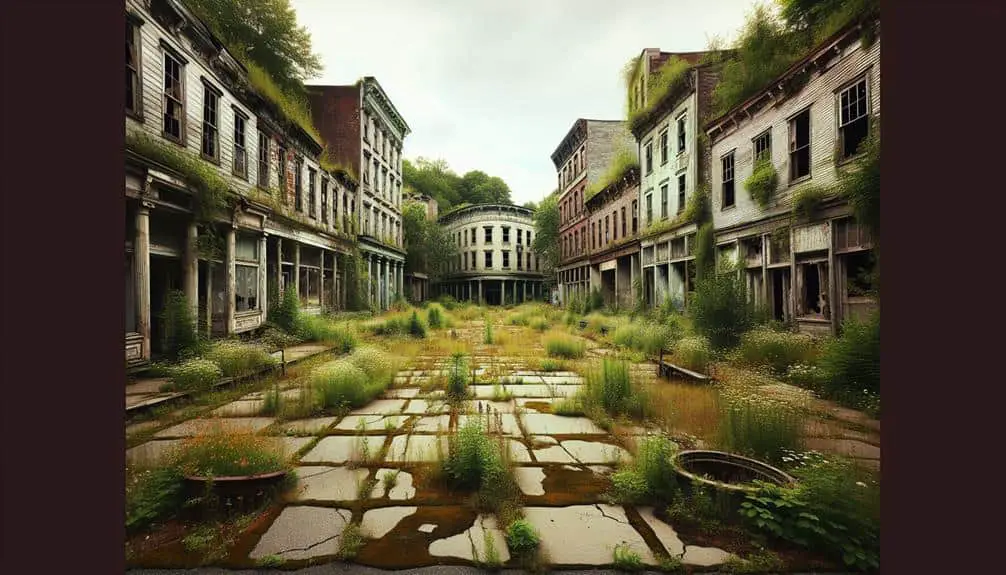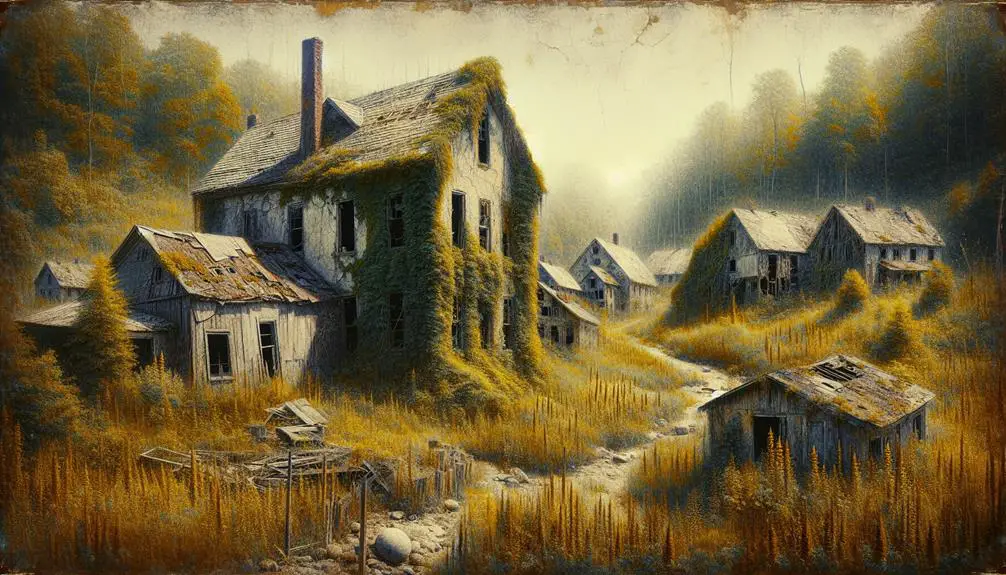Explore the intriguing legacies of the 5 best abandoned utopian towns in the US. Oneida Community Mansion House, founded in 1848, promoted communal living and shared responsibilities. New Harmony Historic District drew intellectuals and artists with its emphasis on education. Amana Colonies showcased a blend of residential and communal structures, preserving their heritage. Brook Farm near Boston focused on self-sufficiency and intellectual pursuits. Harmony Society Historic District embodied utopian ideals through shared resources and meticulous preservation efforts. Uncover the rich history and bold visionaries behind these abandoned utopian towns across the United States.
Key Points
- Oneida Community Mansion House: Founded in 1848 for communal living and social experiments.
- New Harmony Historic District: Established in 1814, attracting intellectuals and artists.
- Amana Colonies: German Pietists seeking religious freedom, known for historic preservation.
- Brook Farm: Emphasized self-sufficiency, promoted equality and social reforms.
- Harmony Society Historic District: Embodied utopian ideals, focused on shared property and resources.
Oneida Community Mansion House
Nestled in upstate New York, the Oneida Community Mansion House stands as a historic proof of a 19th-century utopian experiment. Founded in 1848 by John Humphrey Noyes, this community aimed to create a society based on communal living and social experiments. Residents of the Oneida Community shared property, work responsibilities, and even marriage partners in an effort to achieve a more equitable and harmonious way of life.
The concept of communal living at the Oneida Community Mansion House was central to their social experiment. By pooling resources and living together, members sought to eliminate individualism and create a sense of unity among all residents. This lifestyle allowed for the division of labor based on skills and interests rather than traditional gender roles, fostering a more egalitarian society.
The social experiments conducted within the walls of the Oneida Community Mansion House challenged conventional norms and pushed boundaries in pursuit of a more liberated way of living. Through their commitment to communal living and shared responsibilities, the residents of this utopian community left a lasting legacy that continues to intrigue and inspire to this day.
New Harmony Historic District
The New Harmony Historic District in Indiana stands as a demonstration of a 19th-century utopian experiment that sought to redefine societal norms and structures. Founded in 1814 by German immigrant George Rapp, this utopian community aimed to create a society based on communal living and equality. Here are three key aspects that made the New Harmony Historic District a fascinating example of utopian experimentation:
- Communal Living: Residents of New Harmony shared resources, labor, and responsibilities in pursuit of a harmonious existence. This communal living arrangement was designed to foster a sense of unity and cooperation among the inhabitants.
- Educational Innovation: The community placed a strong emphasis on education, seeking to provide a thorough and progressive learning environment for its members. This focus on intellectual development was a core tenet of the utopian vision in New Harmony.
- Cultural Diversity: New Harmony attracted a diverse group of intellectuals, artists, and scientists who contributed to the cultural richness of the community. This diversity of thought and expertise enhanced the social fabric of the utopian experiment, creating a vibrant and dynamic environment for residents.
Amana Colonies
With a history rooted in communal living and a pursuit of harmonious existence, the Amana Colonies in Iowa exemplify another unique chapter in the tapestry of utopian experiments in the United States. Established by German Pietists seeking religious freedom, the Amana Colonies thrived on the principles of community living and shared work.
The seven villages that make up the Amana Colonies are known for their well-preserved historic architecture and commitment to historic preservation.
The Amana Colonies showcase a blend of residential and communal buildings, reflecting the community's dedication to maintaining their heritage. Through meticulous historic preservation efforts, visitors can experience a glimpse into the past, understanding the daily life and values of the settlers who once inhabited this utopian town.
The Amana Colonies stand as a confirmation to the enduring legacy of communal living experiments in the United States, offering insight into a time when cooperation and shared resources were paramount for the community's survival and prosperity.
Brook Farm
Amid the historical landscape of communal experiments in the United States, Brook Farm emerges as a notable example of utopian aspirations and communal living practices. Founded in the 1840s near Boston, Brook Farm aimed to create a community where individuals could live a pastoral lifestyle while engaging in intellectual pursuits and manual labor.
Here are three intriguing aspects of Brook Farm:
- Self-Sufficiency: Residents of Brook Farm believed in the importance of self-sustainability. They worked together to cultivate the land, raise livestock, and produce goods for their own consumption and to sell in nearby markets. This emphasis on self-sufficiency was a core principle of their communal living experiment.
- Intellectual Pursuits: Unlike many communal societies of the time, Brook Farm placed a strong emphasis on intellectual endeavors. Residents engaged in discussions, debates, and educational activities, fostering a culture of learning and creativity within the community.
- Equality and Social Reform: Brook Farm promoted equality among its members, regardless of gender or social status. The community also advocated for social reforms such as women's rights and the abolition of slavery, reflecting their commitment to creating a more just society through communal living.
Harmony Society Historic District
Nestled in the historical fabric of Pennsylvania lies the Harmony Society Historic District, a proof of 19th-century communal living experiments in the United States. Founded by the Harmony Society in the early 1800s, this district embodies the utopian ideals of its time, where members pursued a harmonious existence through shared property and resources. The Society's beliefs in celibacy, equality, and communal living shaped the landscape of this district, leaving behind a legacy of innovative social experimentation.
Preservation efforts have been instrumental in maintaining the historic significance of the Harmony Society Historic District. Through meticulous restoration and conservation projects, the district stands as a living affirmation to the once-thriving community that sought to redefine societal norms. The buildings, landscapes, and artifacts within the district offer a glimpse into a bygone era of idealistic aspirations and communal unity.
Today, the Harmony Society Historic District serves as a reminder of the bold visionaries who dared to challenge conventional societal structures in pursuit of a utopian ideal. Its historical significance continues to inspire curiosity and reflection on the possibilities of communal living and the enduring legacy of the Harmony Society.
Frequently Asked Questions
What Led to the Eventual Decline and Abandonment of These Utopian Towns?
You asked about the decline of utopian towns. Societal ideologies shifted, economic factors played a role. Environmental changes and cultural shifts affected these communities. Understand that these factors intertwined to lead to their eventual abandonment.
Are There Any Ghost Stories or Paranormal Activities Reported in These Abandoned Utopian Towns?
You've heard tales whispered in the dark, stories of haunted legends and supernatural sightings that linger in the abandoned utopian towns. Paranormal investigations reveal ghostly encounters, adding an eerie veil to these forgotten places.
Can Visitors Still Explore the Abandoned Buildings and Structures in These Towns, or Are They Off-Limits?
You can still explore many of the abandoned buildings and structures in these towns. Urban exploration and photography enthusiasts find these sites intriguing. While some areas may be off-limits for safety reasons, historical preservation efforts drive tourism to these unique locations.
Have There Been Any Efforts to Preserve or Restore Any Parts of These Abandoned Utopian Towns?
Efforts to preserve and restore these abandoned utopian towns have been ongoing. Restoration projects aim to honor their historical significance and cultural heritage. Imagine a tapestry of old and new weaving through time.
What Impact Did These Abandoned Utopian Towns Have on the Surrounding Communities and the People Who Once Lived There?
The abandoned utopian towns had a profound impact on surrounding communities. Societal structures shifted, and people's lives intertwined with the towns' legacies. Community memories hold the historical significance and cultural heritage of these once-thriving utopias.



